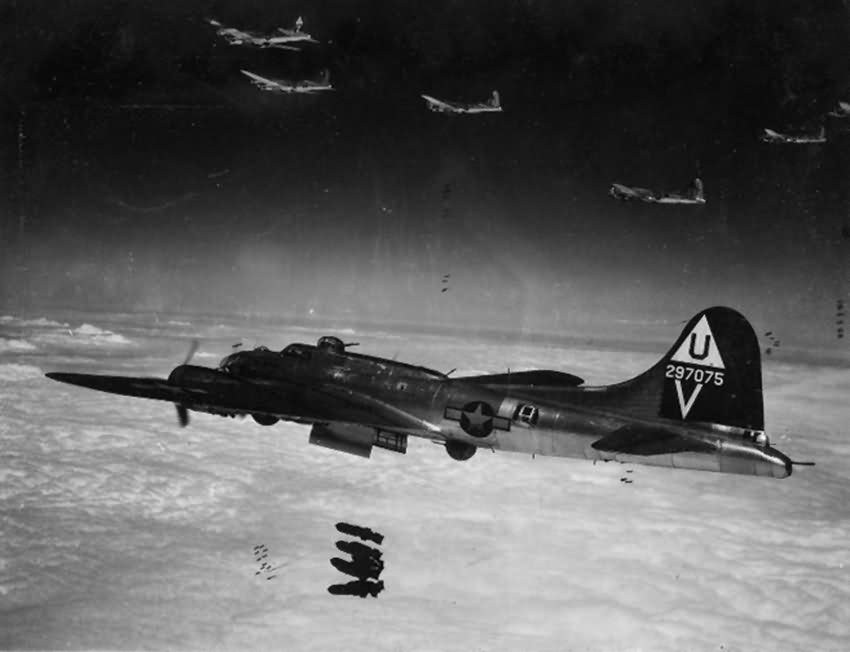The 457th Bomb Group (Heavy):
Overview and Command Assignments
- Assigned to Eighth Air Force: January 1944 – June 1945
- Wing & Command Assignments:
- 1st Bombardment Division (BD), 94th Combat Bomb Wing (CBW): 21 January 1944
- 1st Air Division (AD), 94th CBW: 1 January 1945
Component Squadrons
- 748th Bombardment Squadron (H)
- 749th Bombardment Squadron (H)
- 750th Bombardment Squadron (H)
- 751st Bombardment Squadron (H)
Combat Aircraft
- B-17G Flying Fortress: From block 25 onwards
Station
- Glatton Airfield, England: 21 January 1944 – 21 June 1945
Group Commanding Officers (COs)
- Col James R. Luper: 4 January 1944 – 7 October 1944 (POW)
- Col Harris E. Rogner: 11 October 1944 – August 1945
Mission Details
- First Mission: 21 February 1944
- Last Mission: 20 April 1945
- Total Missions: 237
- Total Credit Sorties: 7,086
- Total Bomb Tonnage: 16,915.5 tons (including 142.6 tons of leaflets)
- Aircraft Missing in Action (MIA): 83
- Enemy Aircraft Claims: 33 destroyed, 12 probably destroyed, 50 damaged
Major Awards
- None
History
- Activated: 1 July 1943 at Geiger Field, Washington.
- Training:
- The group assembled at Rapid City, South Dakota, on 9 July 1943 and underwent first and second phase training.
- Continued training at Ephrata Army Air Base, Washington, from 23 October 1943 to early December 1943.
- Final preparation for overseas service was conducted at Wendover Field, Utah, from 4 December 1943 to 1 January 1944.
- Deployment to Europe:
- The group moved to Glatton, England, in January 1944 to join the Eighth Air Force.
- Redeployment to the USA:
- In May/June 1945, the group returned to the USA.
- Aircraft left Glatton between 19-23 May 1945.
- The ground echelon departed on 21 June 1945 and sailed on the Queen Elizabeth from Gourock, Scotland, on 24 June 1945, arriving in New York on 29 June 1945.
- After 30 days of rest and recuperation (R&R), some personnel reassembled at Sioux Falls Army Air Field, South Dakota, in late July 1945.
- Inactivation: The group was inactivated at Sioux Falls Army Air Field on 28 August 1945.
Aircraft Markings and Color Schemes
B-17G Flying Fortresses (January 1944 – June 1945)
Original Paint Scheme: Dark Olive Drab and Neutral Gray factory finish.
- Triangle U Group Marking:
- A 72-inch-sided white equilateral triangle with a 36-inch Insignia Blue letter “U.”
- On the upper surface of the right wing, the triangle had 96-inch sides and the letter “U” was 57 inches high, with colors matching the tail.
- Call-Letters:
- An individual aircraft call-letter, either 36 inches or 48 inches high, was painted below the tail number in yellow.
- The 48-inch letter was most commonly used on replacement aircraft, but 36-inch and 24-inch letters were also seen.
- All four squadrons used letters in alphabetical order from A, excluding C, E, and I, which were never used as call-letters in the 457th Bomb Group.
- Triangle U Group Marking:
Natural Metal Finish B-17Gs (February 1944):
- The first B-17Gs in natural metal finish received by the 8th Air Force as replacements were concentrated in the 457th Bomb Group.
- The Triangle U on these aircraft was a white letter on a black triangle, and the call-letter was also in black.
Propeller Hubs Colors (Summer 1944):
- 748th Bomb Squadron: Red
- 749th Bomb Squadron: Blue
- 750th Bomb Squadron: White
- 751st Bomb Squadron: Yellow
Nose Markings (August 1944):
- The aircraft call-letter, followed by the last three digits of the serial number, was painted in approximately 12-inch high characters on both sides of the nose, directly aft of the bombardier’s Plexiglas.
- The color was yellow on camouflaged aircraft and black on bare metal.
- In some cases, the call-letter was omitted from the nose, a practice that later became general relative to nose numbers.
- Some aircraft had the call-letter, approximately 20 inches high, painted on the chin turret sides during the final months of hostilities.
Tail Markings (August 1944):
- A 48-inch wide Insignia Blue stripe was painted diagonally across the vertical tail, with the lower end forward and the higher end at the top of the rudder.
- On most aircraft, the Group insignia, tail number, and call-letter were left with a bare metal margin.
- Smaller call-letters were more commonly used on replacements, with 20-inch high letters on several aircraft, especially in the 751st Bomb Squadron.
Wireless Telegraphy (W/T) Codes (Mid-May 1945):
- The current W/T codes were used in the anti-low flying program as an underwing identity marking.
- Codes used, plus the aircraft letter as a suffix:
- 748th Bomb Squadron: RUW
- 749th Bomb Squadron: JOB
- 750th Bomb Squadron: PPL
- 751st Bomb Squadron: MJA
